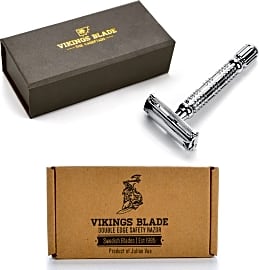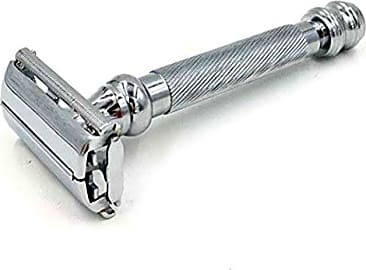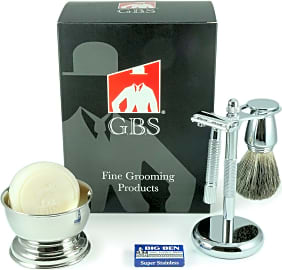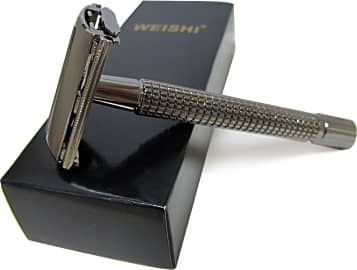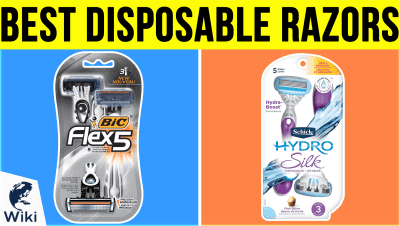The 8 Best Safety Razors

This wiki has been updated 41 times since it was first published in May of 2015. Refined gentlemen know how important smooth facial skin is, and if you are one of those gentlemen, you can take your morning routine to the next level with a good safety razor. Coming in an array of elegant styles that are easy to care for, they are designed to provide a close, comfortable shave without any nicks and without leaving any bumps or redness. Some even offer adjustable blade gap width. When users buy our independently chosen editorial choices, we may earn commissions to help fund the Wiki.
Editor's Notes
June 11, 2021:
We removed a pair of models that we discovered were difficult to get your hands on and were also made redundant by some of our better selections. One other minor change made was the elevation of the Merkur Futur to the #2 spot. Its advanced design and magnetized assembly make it easy to use and maintain, and its blade gap adjustment is second to none in terms of convenience and reliability. The rest of our rankings remain the same as last time around.
February 11, 2020:
A fair amount of time had passed since our last update, so we revisited this list with a critical eye to ensure it is up to date with the best and most current offerings. There's no surprise that certain well-made, tried and true items like the Feather AS-D2 maintained pride of place, while models like the Baxter of California Double Edge and Colonel Conk Kit have been usurped or become unavailable. We also said goodbye to our previous Parker 96R Set in favor of the single, well-loved and reliable Parker 99R. This sleek selection is handcrafted from durable, quality materials and has an entry-level price tag, making it perfect for newbies breaking into the wet shave world.
Also joining the ranks today is the Edwin Jagger DE and Merkur Futur. The latter is a high-quality, middle of the road selection available in a wide range of styles, with short, long, and regular handles, as well as multiple colors and handle pattern types. The former is a modern, two-piece design that snaps together easily thanks to embedded magnets, with an adjustable head that gives it a versatility many of its competitors lack.
We wanted to showcase models suitable for beginners and veteran shavers that are priced for a range of budgets and feature varying levels of aggressiveness. We favored units made by experienced companies using top of the line materials with thoughtful designs, so that even the most basic, entry-level pieces, like the Weishi Nostalgic or Handlebar Shaving The Prospector, are leaps and bounds from your typical disposable razor.
Special Honors
Charcoal Goods Copper Level 2 Made for those who want form as well as function, razors from Charcoal Goods are designed and manufactured in the United States and built to last for years. The Copper Level 2 is a complete CNC-machined solid copper safety razor with a bright, shot-peened finish. It includes a handle, mid-aggressive base plate, and a razor top cap, but no blade. There are several unique designs available for the handle. charcoalgoods.com
The Art of Shaving Rose Gold This limited edition piece from The Art of Shaving and Mühle of Germany provides a touch of elegance alongside a close shave. It sports a closed comb, double-edged razor that is less aggressive than an open comb for better control, finely engraved handle, and a copper and gold plating mix with chrome accents over Zamak metal. theartofshaving.com
The Abridged History Of Shaving
In some cultures, such as in Ancient Egypt, this meant only a trimming of the mustache while the beard of the chin grew long.
A man's beard has long been a symbol of wisdom, experience, and of course, masculinity. Ancient civilizations including Mesopotamia, India, and Sparta treasured the beard, as indicated by their recovered arts, coins, and writings. As far as historical and archeological evidence can tell, however, men from multiple other cultures were regularly shaving their faces well into antiquity.
In some cultures, such as in Ancient Egypt, this meant only a trimming of the mustache while the beard of the chin grew long. Many Ancient Greeks, such as Alexander the Great, went entirely clean shaven, a practice also adopted by and spread across much of the Roman Empire.
The popularity of the beard grew during the Middle Ages, as knights and nobles proudly wore their beards as signs of chivalry and bravery. The beard waned in popularity during the later Renaissance and into the 17th and 18th centuries, years during which members of the aristocratic classes thought beards to be a symbol of low breeding and crassness.
The 19th century was a golden era of the beard, particularly in America. A new sense of virility washed over the country as it filled in the vast spaces between its Atlantic and Pacific borders with bold new "pioneers" heading west. The Gold Rush of 1849 in particular ushered in a new generation of men who proudly wore beards -- this was partially out of stylistic conscience, and partly a matter of convenience, which is to say that shaving regularly was inconvenient. The Civil War era saw the apex of beard wearing in that century.
Today, most men in America go clean shaven. In fact, only about one third of adult American males sport facial hair of any kind, though there has been a recent resurgence of beards among younger men. Most modern men regularly reach for their razors and remove the hair that sprouts from cheek, chin, lip, and neck.
Choosing A Safety Razor
Here are two things to clear up before we discuss choosing the right razor for your shaving needs: the term safety razor refers to a handheld razor with a blade (or blades) set at a right angle to the handle and with only a slim portion of the razor exposed. The term does not refer to an electric shaver or any other device. A straight razor, by contrast, is nothing more than a sharp blade with a handle attached.
If the blade you're considering uses a different technique, make sure you're comfortable with it before you commit.
Second, safety razors of the type with actual blades the user replaces regularly are perfectly suitable for a man's face or for a woman's body. They are no more prone to cut even sensitive skin than is a cartridge based reusable razor or a disposable razor.
And in the long run, choosing a permanent handle made of a solid material like steel or resin and replacing the cheap but durable and effective metal blades will actually save you money as compared to relying on the expensive cartridge blades sold by well known brands. So the choice to switch to an all metal blade razor is economically sound. And style wise, it's a brilliant move. Few personal hygiene tools look half so attractive as a classic safety razor, and you can readily be forgiven for choosing your razor as much for how it will look there on the sink as for how you think it might offer a shave.
Once you have decided if you prefer a razor with a black, silver (e.g. chrome) or gold hued handle, the next consideration should be handle length. Some safety razors have shorter, thicker handles which will feel right for some users who like to have a sturdy grip on their razor. Others feature longer, slimmer handles, better for those who shave with deft, precise movements.
Also take a moment to consider the blade changing mechanism of your prospective razor; most use an easy twist open "butterfly" style of head, which is easy to master. If the blade you're considering uses a different technique, make sure you're comfortable with it before you commit.
Proper Shaving Technique And Razor Maintenance
The more often you shave, the better each shaving experience will be. Especially for the hirsute gentleman, a daily shave means skin that is less irritated, a faster shave each time, and a face that looks clean and healthy. Replacement blades for most safety razors are relatively affordable, so treat yourself to a new blade as soon as you sense the one you are using is losing its edge. Sharp blades are not only more effective than duller blades, but are safer, too, leading to fewer nicks and cuts.
After you have applied your shaving cream, gel, or lotion, wait another minute or two before you begin to shave.
Make sure to thoroughly wet your facial hair with warm water before you start to shave, and give yourself time to let the water soak in. Doing so will soften the hairs, making them easier to cut, and will open your pores up, lifting follicles closer to the surface of the skin. After you have applied your shaving cream, gel, or lotion, wait another minute or two before you begin to shave. You should identify the proper shaving pattern for your face, working first with areas of least thick hair concentration and moving toward thicker areas (this often means cheeks first, then lips and chin, for example). Make sure to clean your blade after each pass, and reapply shaving cream if needed.
Remember, when your razor is not being used, it should be clean and dry. Even stainless steel can tarnish and rust if left wet for long enough, and the shaving cream, soap scum, or mineral deposits that can build up on a razor can render it ineffective over time. The best way to get the most use out of each blade -- not to mention out of the razor's handle, which should last years and years with proper care -- is to thoroughly rinse it after use, then blot it dry with a clean towel and hang it up or lay it on a clean, dry surface such as a block of hardwood.



